Is Guanajuato the prettiest city in Mexico? Well, I haven’t seen them all so I can’t answer with a resounding “Yes!”, but it will definitely put up a good fight with any contender.
This colonial city was founded by the Spaniards in the mid 16th century and became a UNESCO World Heritage Site in 1988.
Its rich past comes from silver mining. It generated incredible wealth in the 17th and 18th centuries, reflected in the grandiosity of its theatres and churches.
The narrow cobblestone streets sandwiched between yellow, pink, and blue walls, crowned with wrought iron balconies, beg to be walked.
You can spend an entire day (or two) in the Historic Centre visiting the churches and museums, strolling the colourful streets, and relaxing in the lovely squares.
Explore the hiking trails in the surrounding mountains and walk among forests and birds.
You can visit Guanajuato as a day trip from San Miguel de Allende (a 1.5-hour bus ride away), but it’s worth spending at least two days here to walk around without rushing, visit a couple of museums, explore the nearby trails, and hang around the centre at night.
Good to know: Guanajuato is a city in the state of Guanajuato (Gto.)
Disclosure: This post contains some affiliate links. If you make a purchase through those links I will earn a commission at no additional cost to you (zero, nada). To check the full disclaimer, click here.
Here are the best things to see and do in Guanajuato in 2 days.
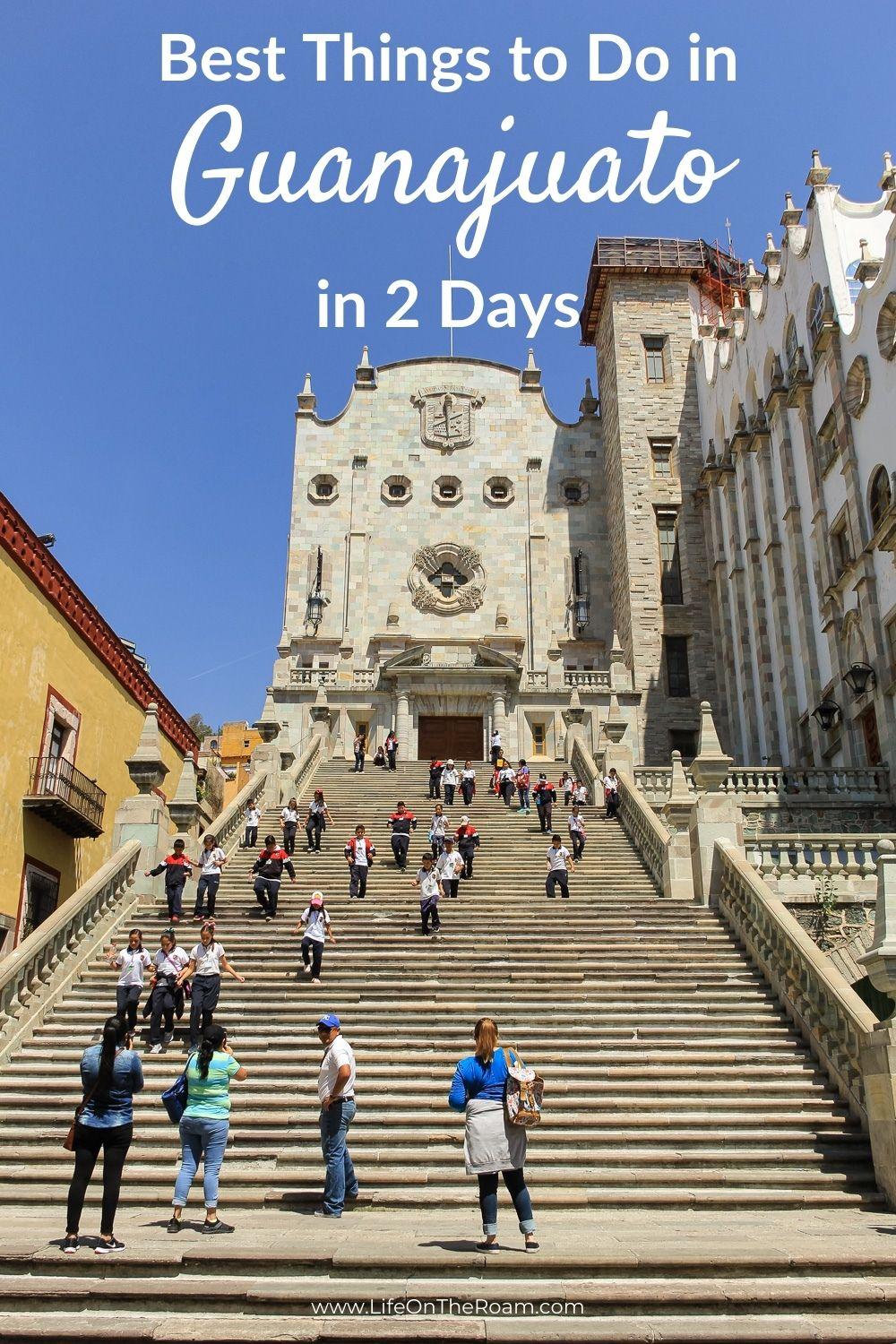
Table of Contents
Day 1: Visit Guanajuato’s Historic Centre
Grab a comfortable pair of shoes as you’ll do a lot of walking up and down narrow streets, most of them pedestrianised. That’s possible thanks to the tunnels that were built to prevent flooding which are now used as underground roads.
I put together a route including stops to museums, places with outstanding architecture, historic landmarks, and lovely squares to relax. Check the map and list below and choose what to do according to your preferences and schedule.
Jardín de la Unión
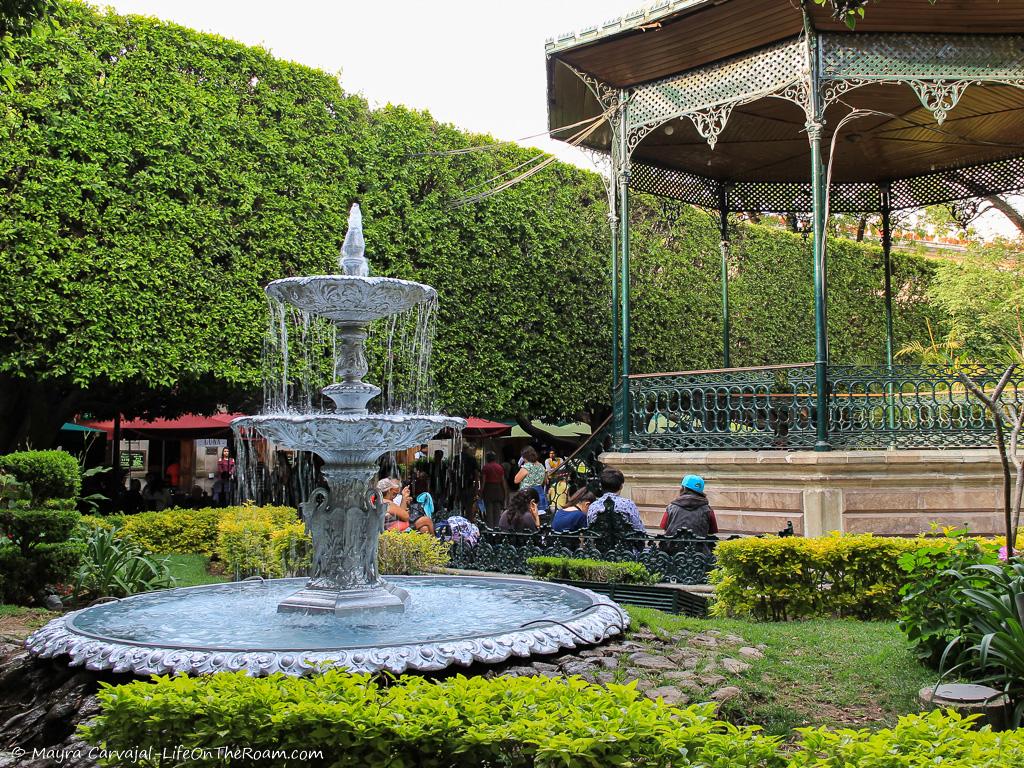
Let’s start here as Jardín de la Unión has been the epicentre of social and cultural life in Guanajuato since the 19th century. Day and night people flock to this park to meet with friends, sit on the benches and enjoy the fountains and surrounding topiaries.
If you’re staying overnight come back in the evening to see it blossom with the magic of lighting, live music, and a buzzing scene.
Walk a few feet from here to check out the Church of San Diego and the Teatro Juarez.
The Church of San Diego
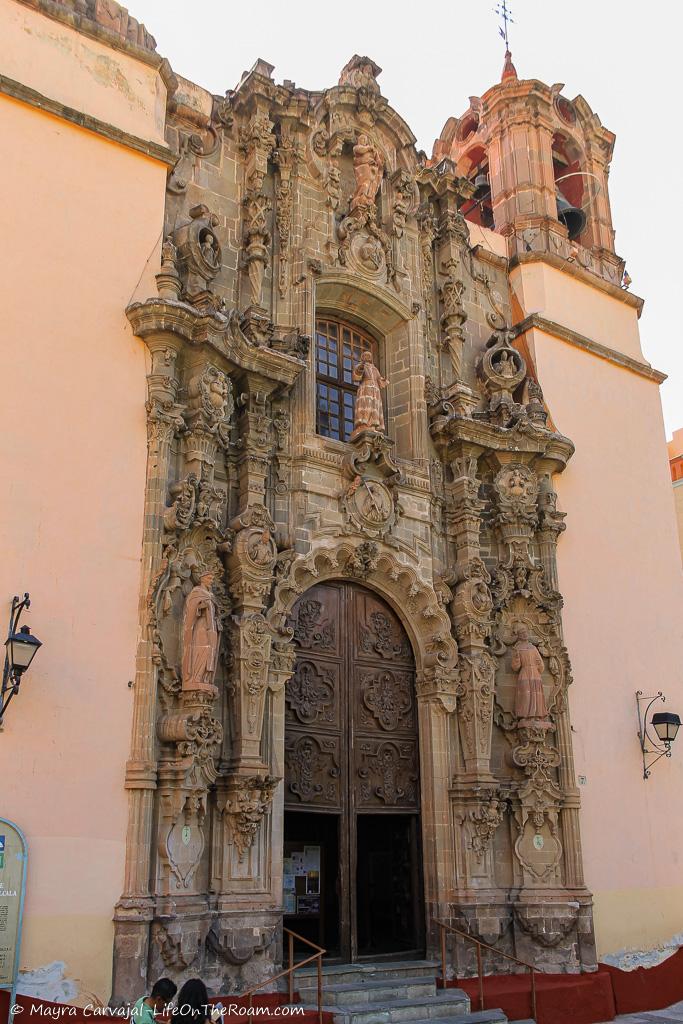
If you were standing here in the 18th century you would be looking at a much bigger building with five chapels instead of three.
But the church of San Diego has been through some challenges since 1663 when the Barefoot Franciscans founded the first monastery in the city of Guanajuato.
In 1780 the city flooded and the church (and pretty much every building around) had to be raised.
After the government passed new laws it took possession of the monastery to build a hotel (the same one that was later demolished to build the Teatro Juarez next door).
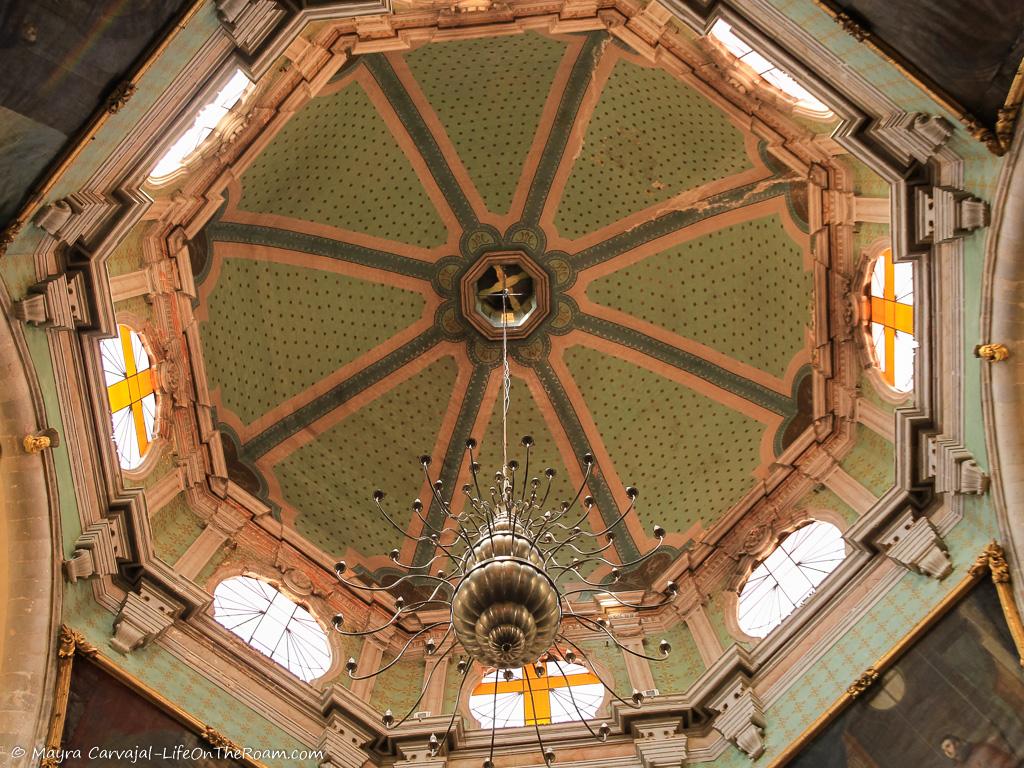
You can still admire what’s left, with a gorgeous Rococo façade, and the underground museum with paintings from the colonial era.
Teatro Juarez
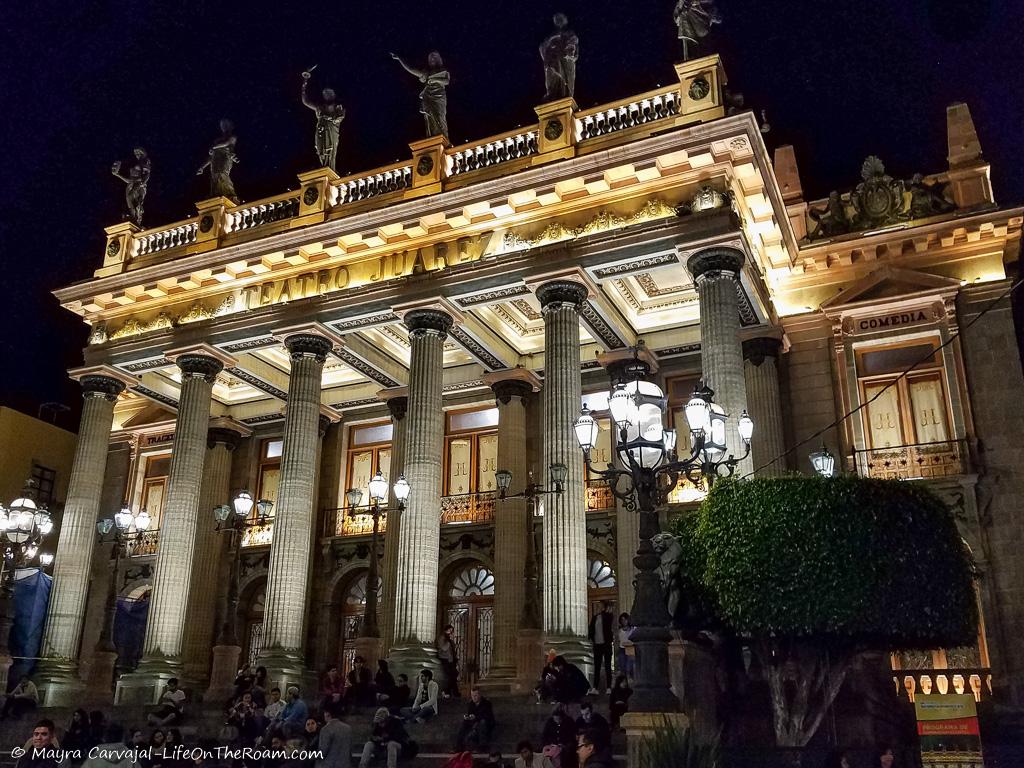
The magnificence of this building is another testimony of the wealth of Guanajuato in the 19th century, thanks to the mining industry.
The construction started in 1873 on a site occupied first by a monastery (part of the church of San Diego next door), and then a hotel. The ruins of the monastery can still be found below street level.
It opened its doors in 1903 with a neo-classical facade and an eclectic style. The statues at the top are the muses representing the arts.
The first play on stage was the opera Aida
Take a closer look at the doors, the soffit, and the wrought iron in the balconies. Exquisite.
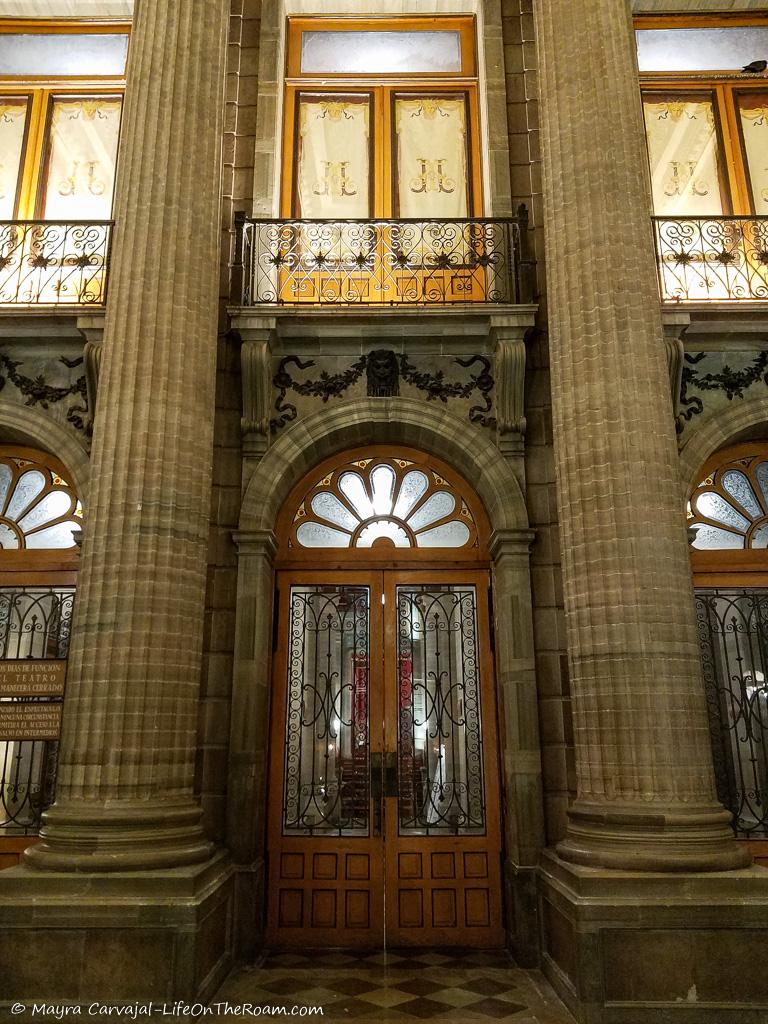
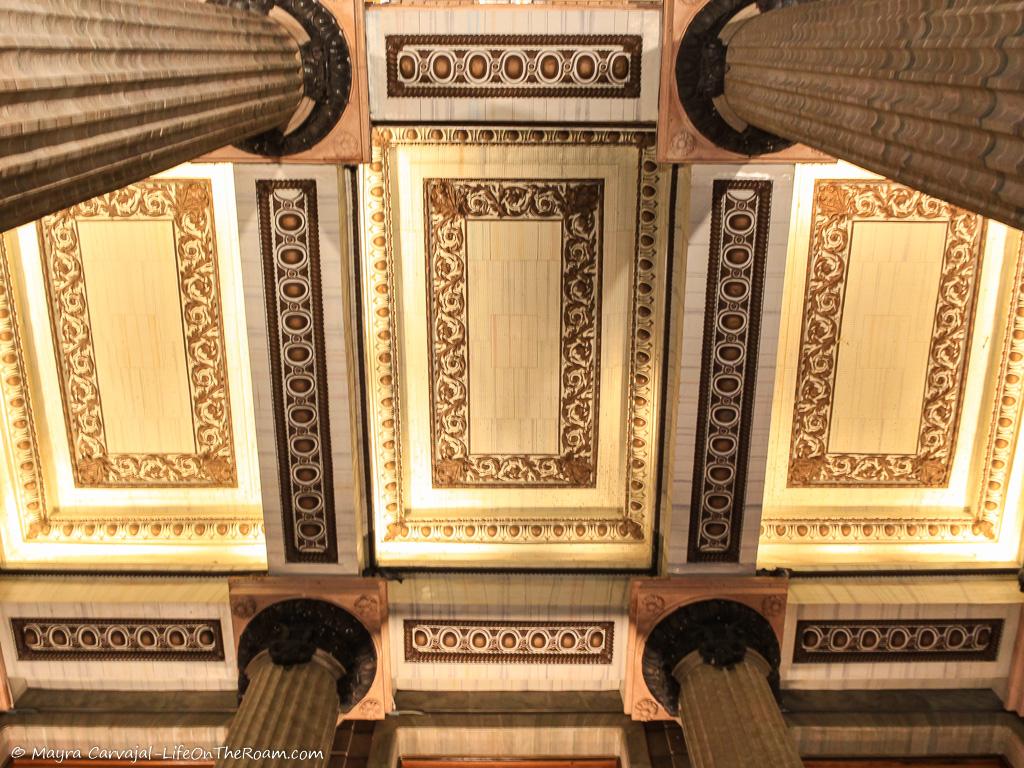
I’ve heard the interiors are even more beautiful than the exteriors. Unfortunately, I won’t be able to confirm that as the two times I was there it was closed in preparation for an event.
If it’s open when you’re around, don’t miss the chance to go in and join their tour. Or even attend a concert or any other event at this fantastic venue. Now walk north towards the largest church in town.
Architects: Jose Noriega and Antonio Rivas Mercado
Basilica of Our Lady of Guanajuato
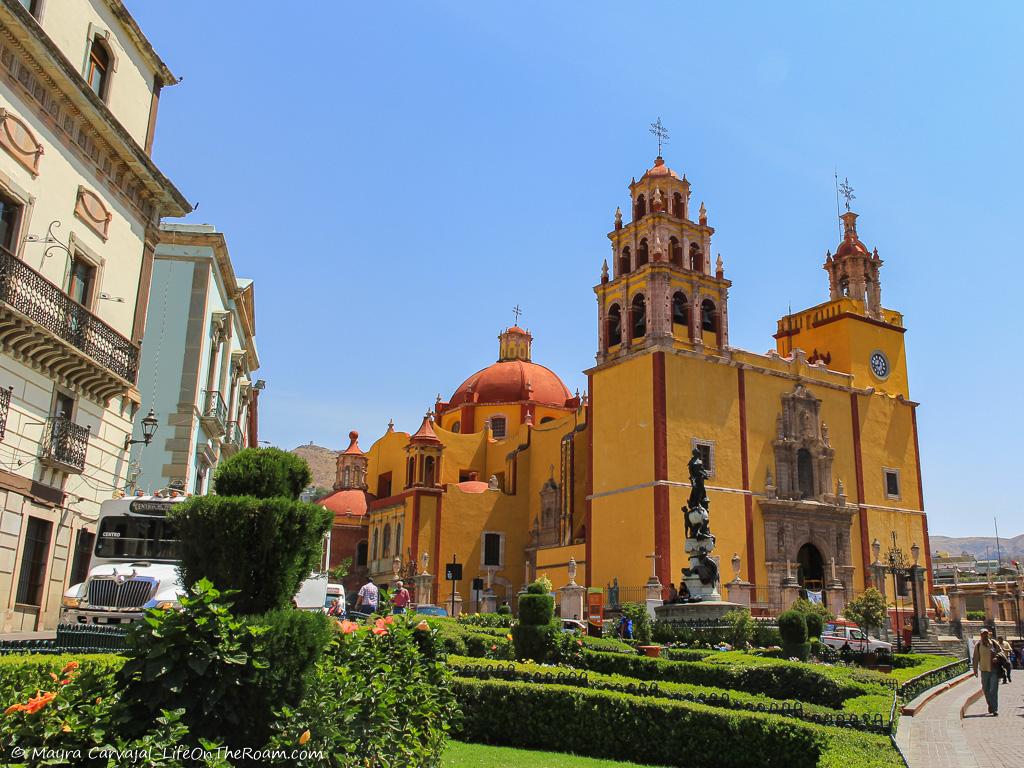
Back in 1671, the silver mines were making a lot of moolah, so much that the owners decided to build this magnificent church, the pièce de résistance of Guanajuato.
It commands the Plaza de la Paz square with its Baroque Mannerism style and the pink sandstone carving in the facade.
In 1696, the year the church was finished, King Philip II sent the wooden statue of Mary on a silver base you can see behind the altar.
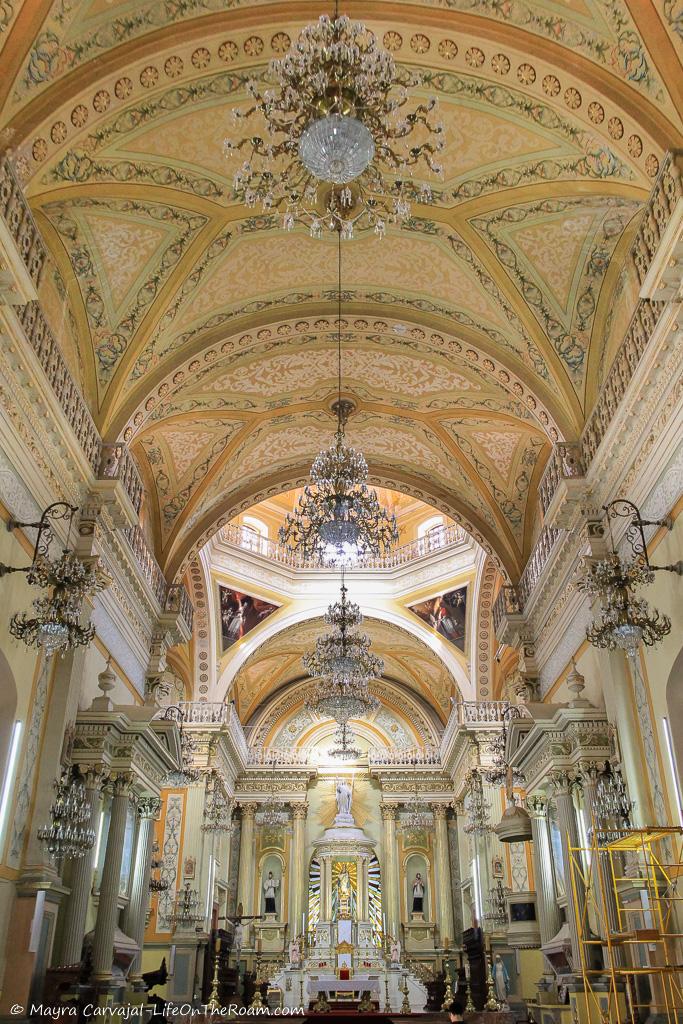
Keep walking north to see some historical landmarks.
The University of Guanajuato
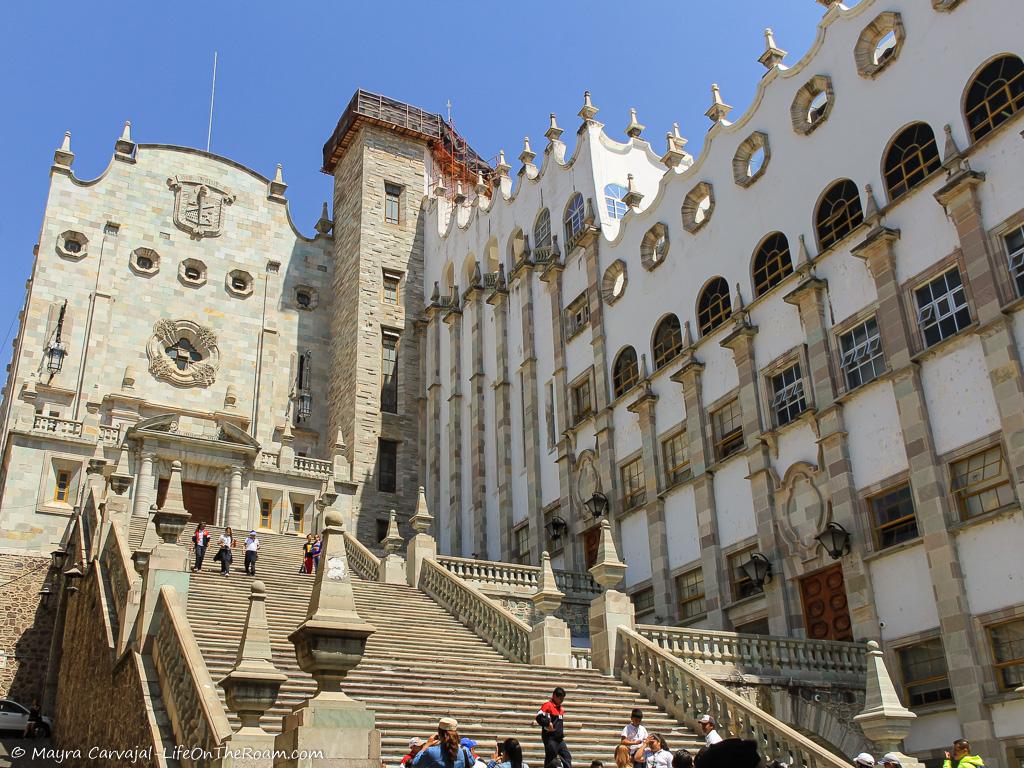
Before becoming a university this building was a hospice (back in 1732) and then became a school of arts and philosophy.
This building gives me some Game of Thrones vibes as if one of the Lannisters will storm out the doors at any moment. Same to you?
Templo de Los Hospitales (Hospitals’ Church)
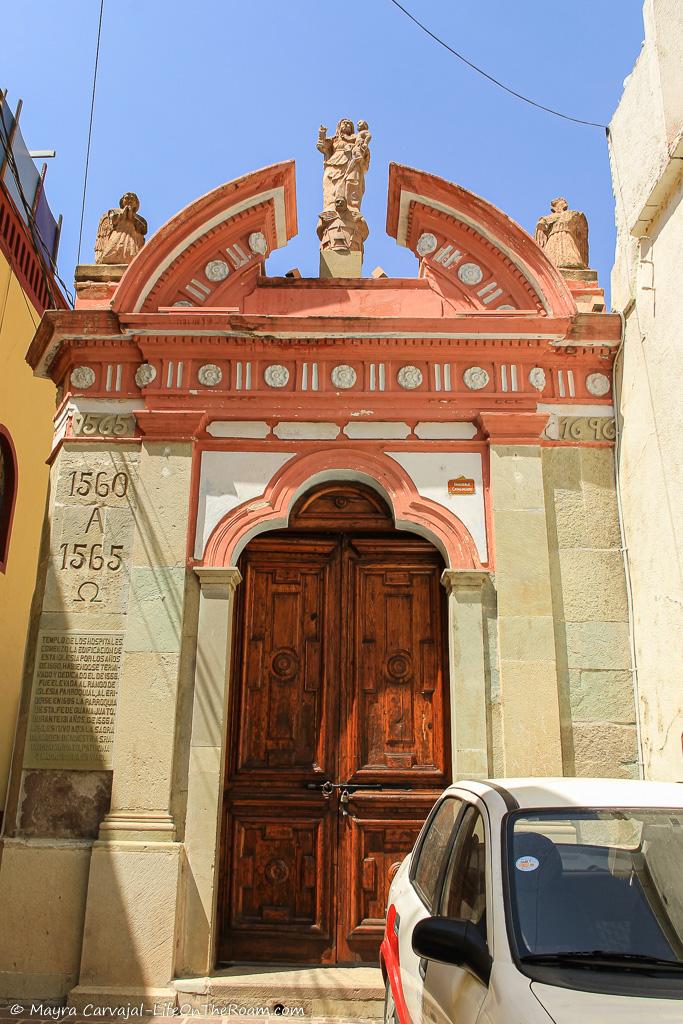
As the name suggests, this cute blink-and-you-miss-it church was built next to one of the hospitals that treated the indigenous population who worked in the mines.
This was the first church built in Guanajuato, between 1560 and 1565.
Keep walking north along Positos Street to see the artwork of Diego Rivera.
Museo Casa Diego Rivera: The Birthplace of Mexico’s Most Famous Muralist
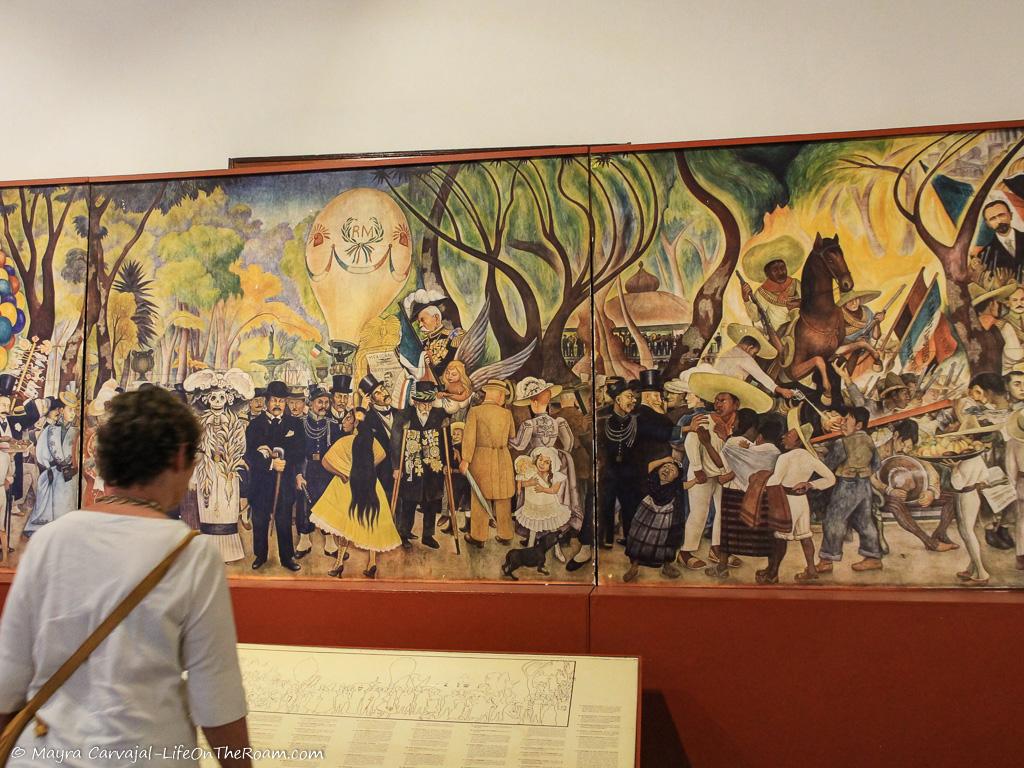
Any other fans of Rivera’s work in the house?
The celebrated Mexican artist was born in this property in 1886, living here until he was six years old and occupying one of the rooms located on the ground floor.
Late 19th-century furniture recreates the ambiance of the time when little Diego played around this house, restored under the supervision of his daughter.
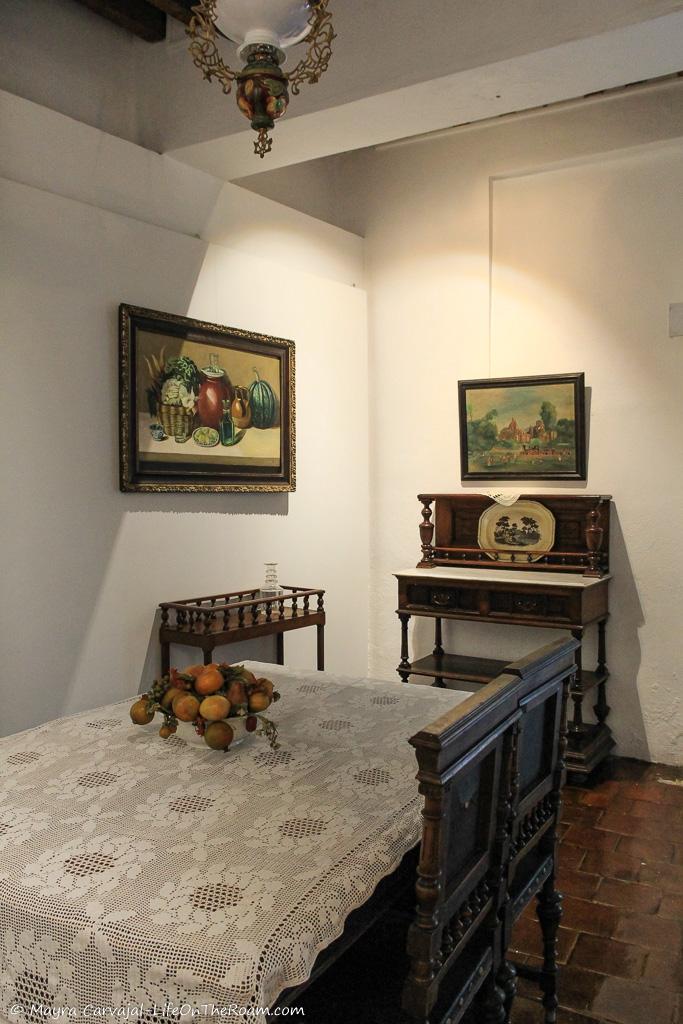
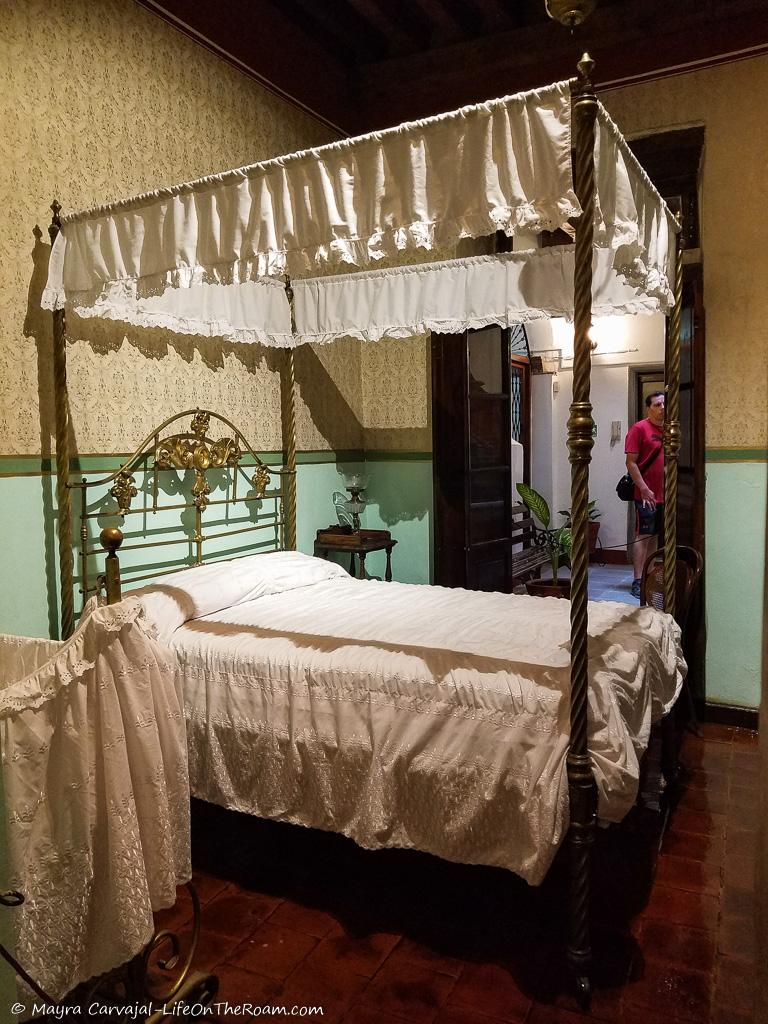
You’ll see a display showing the evolution of his work from an early age: ink and pencil sketches, watercolours, and lithographs.
On the top floor, there’s a picture at a reduced scale (but still large) of Dream of a Sunday Afternoon in Alameda Park, a stunning mural you can see in full splendour at the Museo Mural Diego Rivera in Mexico City, along with temporary exhibits from other artists.
If you’re ready to take a break or have lunch head west to the San Fernando Square.
Diego Rivera’s House Museum
Positos No.47; Open Tue. to Sat: 10AM-7PM, Sundays: 10AM-3PM; General admission: MXN 25.00
Plazuela de San Fernando
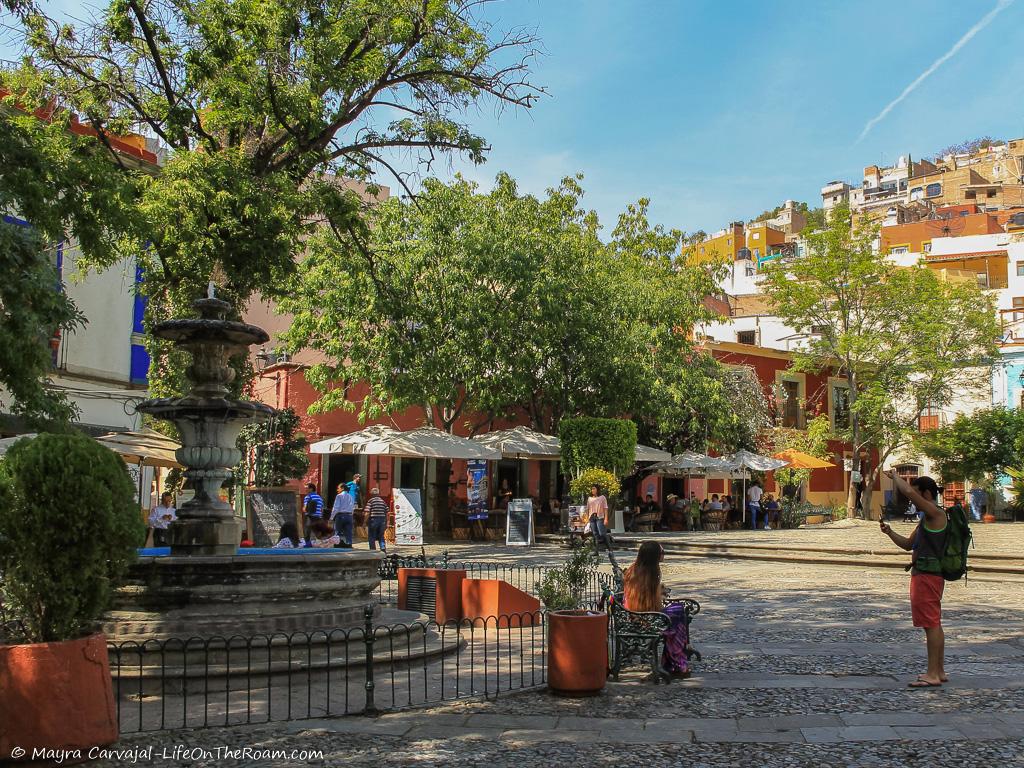
This small square felt like a happy little oasis, with colourful facades, trees all around and a lovely fountain. Perfect to take a break and get a bite to eat at one of the nearby cafes. We enjoyed lunch at Cafe Bossanova.
Now head southeast for some awesome desserts.
Sweet tooth alert: Xocola-t and La Vie en Rose
Stop at Xocola-t, a chocolate boutique with delicious creations bursting with unique flavour combinations. I loved these ones: balsamic vinegar with cardamon, cajeta (goat milk candy) with blue cheese and black salt, and the mezcal shot. Oh, chocolate!
Xocola-t is at Baratillo 15, across the famous Plaza del Baratillo, a small square with a lovely 19th-century florentine fountain.
A few feet south, in Cantarranas 18, you’ll be delighted with the tartes from La Vie en Rose.
After you’re done with your sugar fix go right next door to see what was Guanajuato’s first theatre.
Teatro Principal de Guanajuato
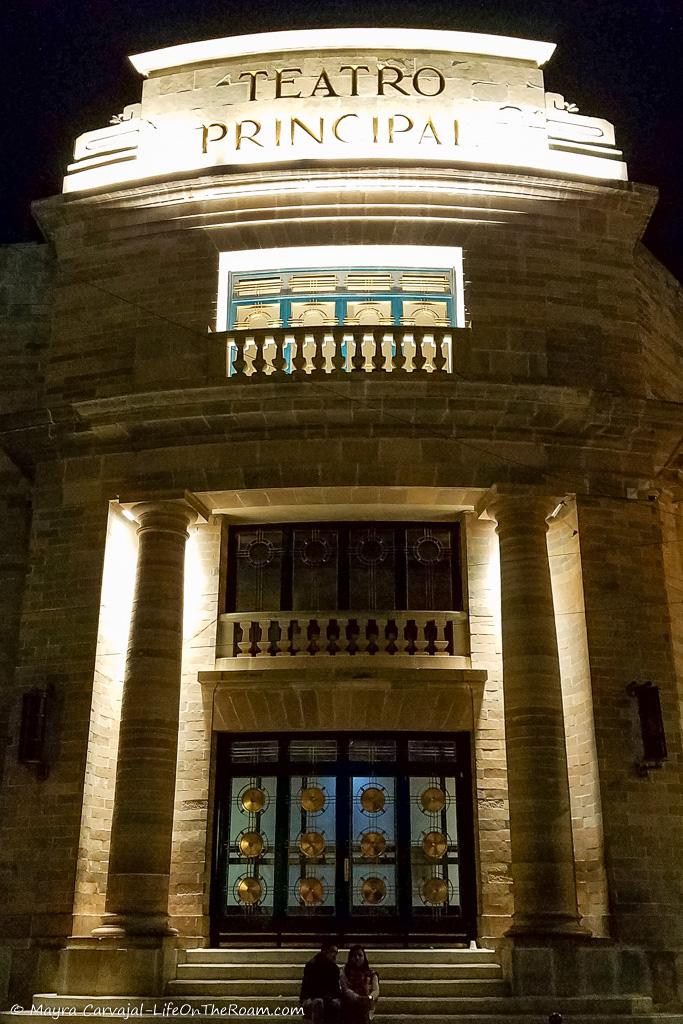
This was the first theatre to open in the city in the 18th century, in a neoclassical style. It’s an important venue for major cultural festivals.
From here reach Calle De Sopeña (a street with beautiful colonial buildings) and head south until you find the San Francisco church.
Templo de San Francisco (San Francisco Church)
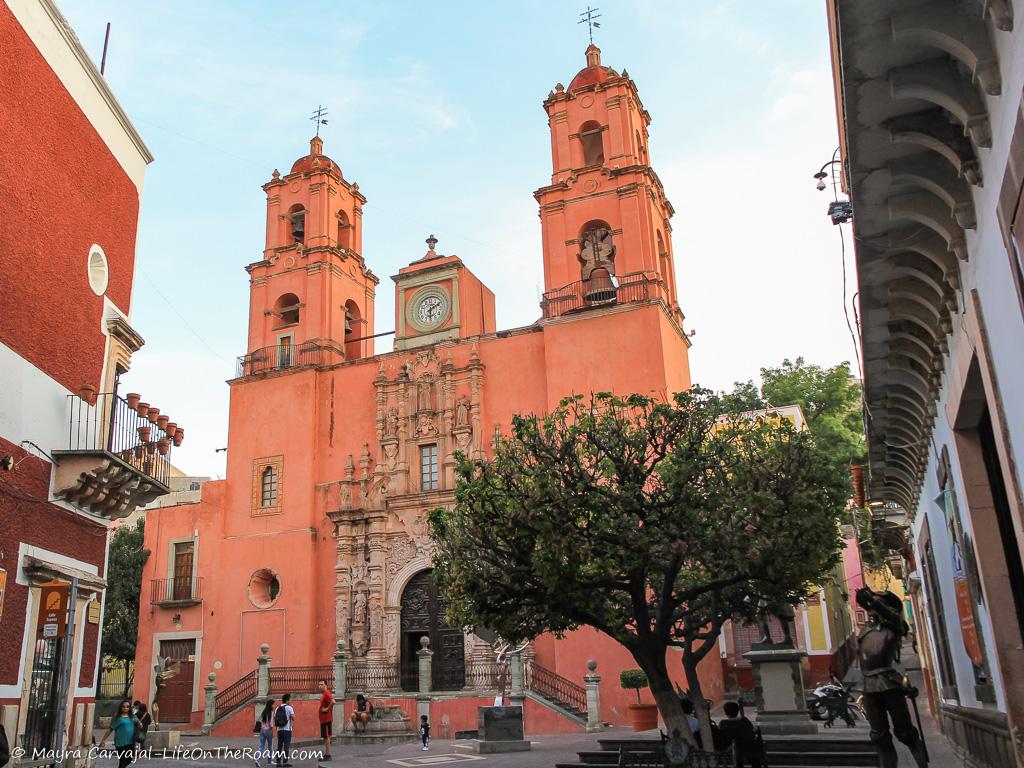
Even though the Basilica of Our Lady of Guanajuato is bigger and more imposing, I prefer the sandstone carvings in the entrance of this church, in Baroque style with nature-inspired motifs and small niches.
Up to the 18th century, this was the Saint John the Baptist church, but at the end of the 19th century, it became the church of San Francisco.
Inside you’ll find a more neoclassical interior (the church was renovated in the mid-19th century), with the typical Corinthian columns.
I loved the leaf-inspired paintings adorning the vaulted ceilings.
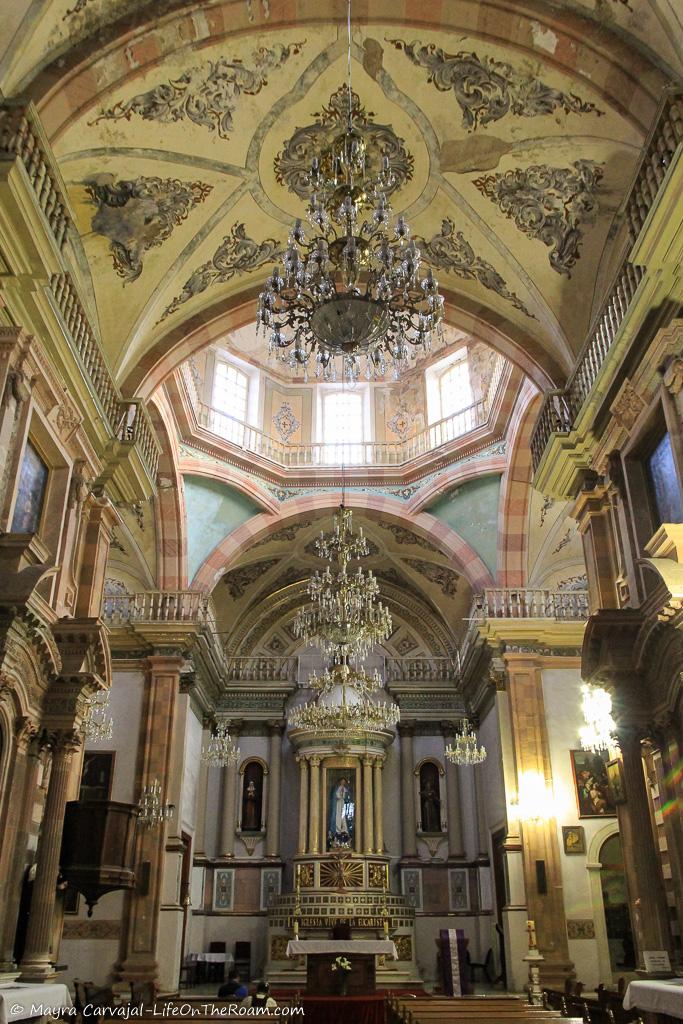
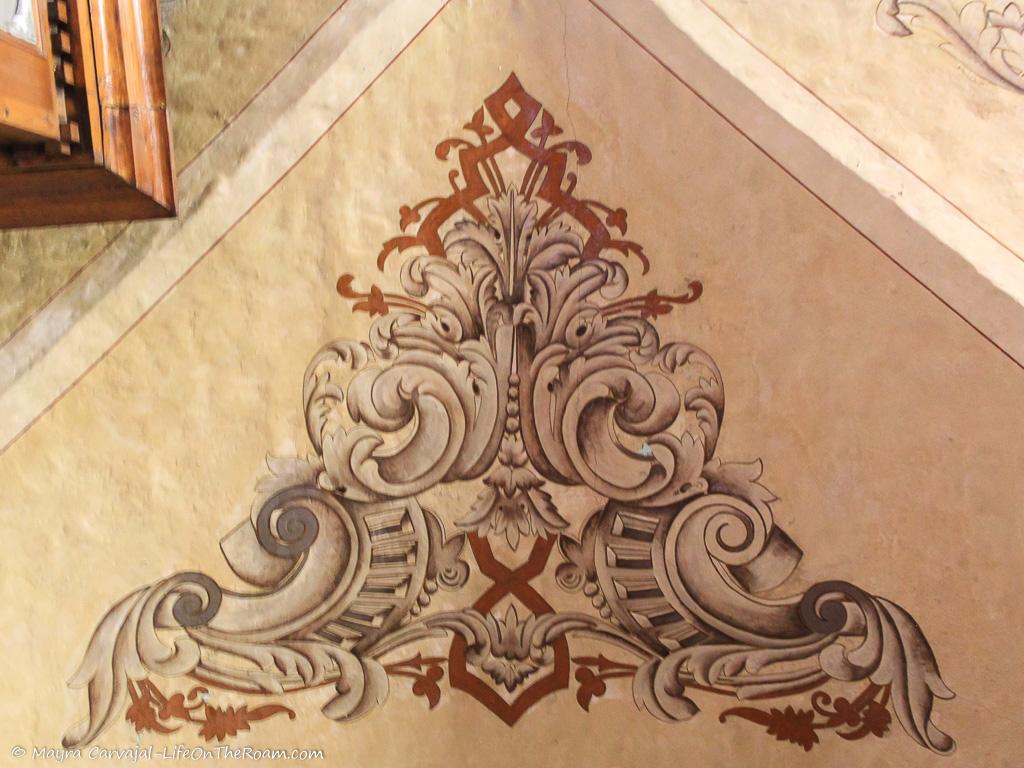
If you’re a fan of Miguel de Cervantes and his masterpiece, Don Quixote, you may want to visit the nearby Don Quixote Iconographic Museum.
If you want to enjoy one of the best panoramic views of the city take the funicular behind Teatro Juarez.
Enjoy the City Views from the Monumento al Pípila Lookout
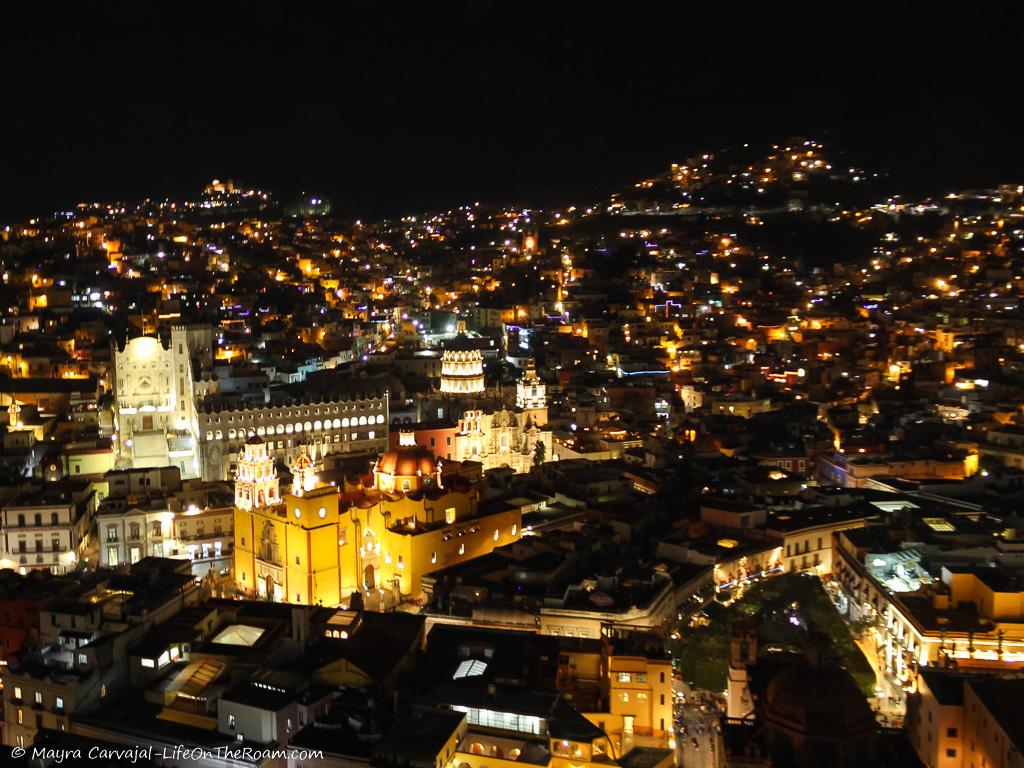
When walking around Guanajuato you’ll see him from everywhere, standing proudly with his right arm up in the air holding a torch, and his left arm resting on a stone slab.
I’m talking about El Pípila, a hero of the war of independence, sort of a legend. People say he set fire to the door of the Alhóndiga de Granaditas (the grain exchange building) in 1810, carrying a heavy slab on his back as shield.
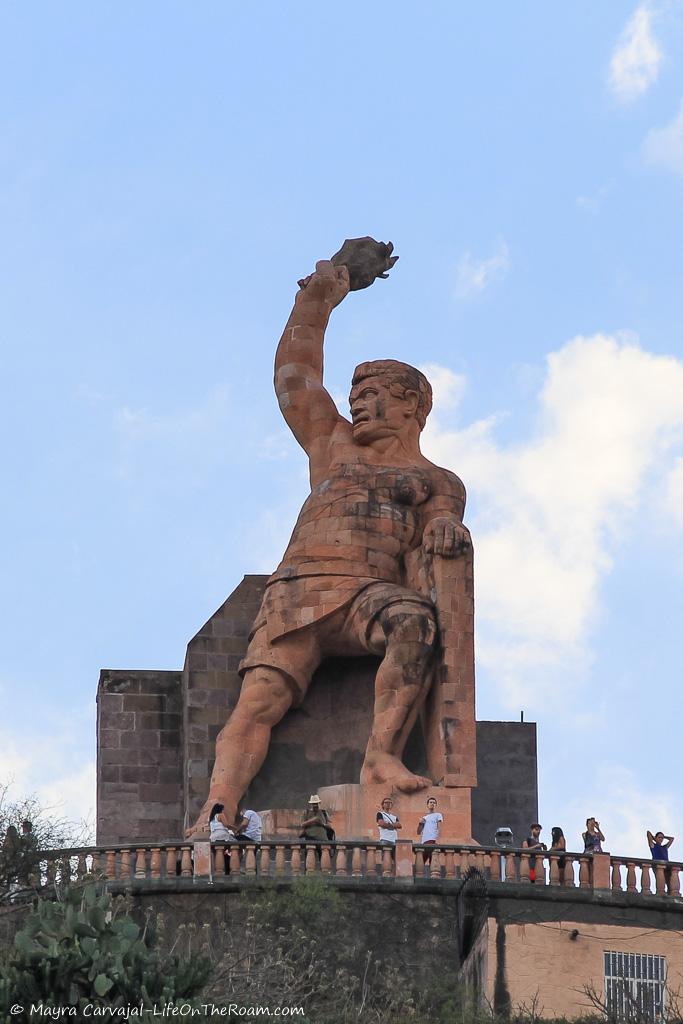
Like El Pípila, you too can overlook the city standing in front of the massive pink sandstone monument built in his honour.
The best way to get here is to take the funicular behind Teatro Juarez.
Now get ready to see Guanajuato after dark.
Guided walking tour of Guanajuato: you like what you see so far? This 2.5/3-hour tour covers history, legends, and traditions as you walk around the beautiful buildings of the city.
Learn more with this tour, with a rating of 5/5 based on more than 185 reviews.
Do you prefer a private walking tour tailored to your interests? Check out this tour, with a rating of 5/5 based on more than 270 reviews.
Explore Guanajuato’s Centre at Night to See the City in a New Light
Guanajuato centre at night is a busy place, especially around the Jardin Union area. Not only is this city popular with tourists, but it’s also a university town with lots of young people, and of course with lots of vendors filling the streets after dark.
The narrow streets and many historic buildings in the centre are lit up and although you may have already seen them during the day, the spotlights will highlight the artistry of the ornamentation.
The church of San Francisco, the Basilica, and the church of San Diego are a must-see. The intricate carvings in their façade, typical of the Baroque and Rococo styles, get a 3D boost under the lights.
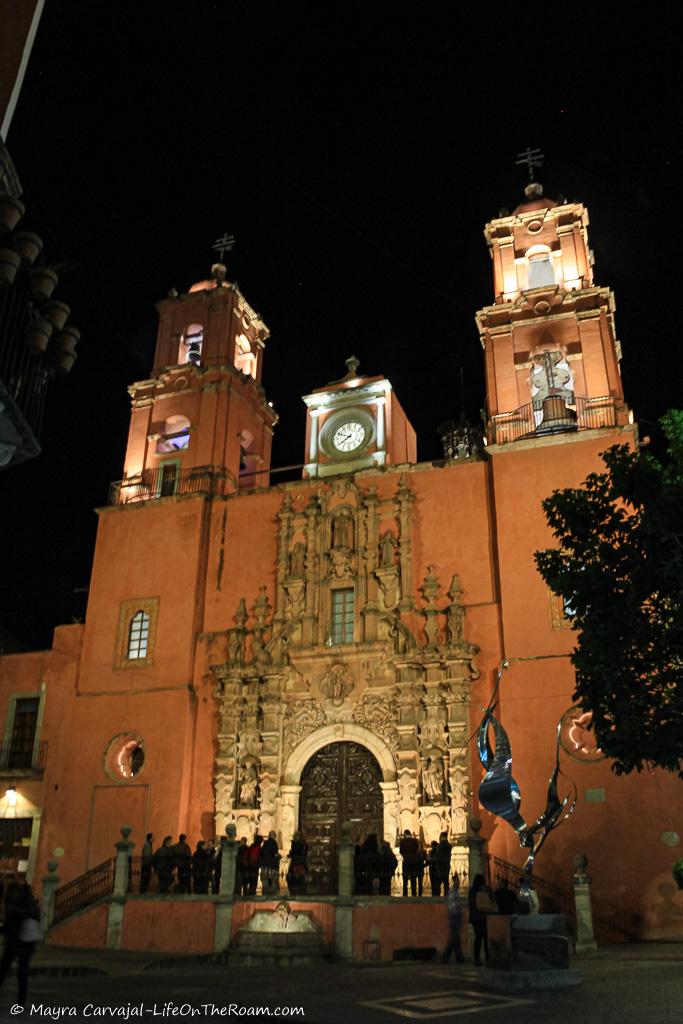
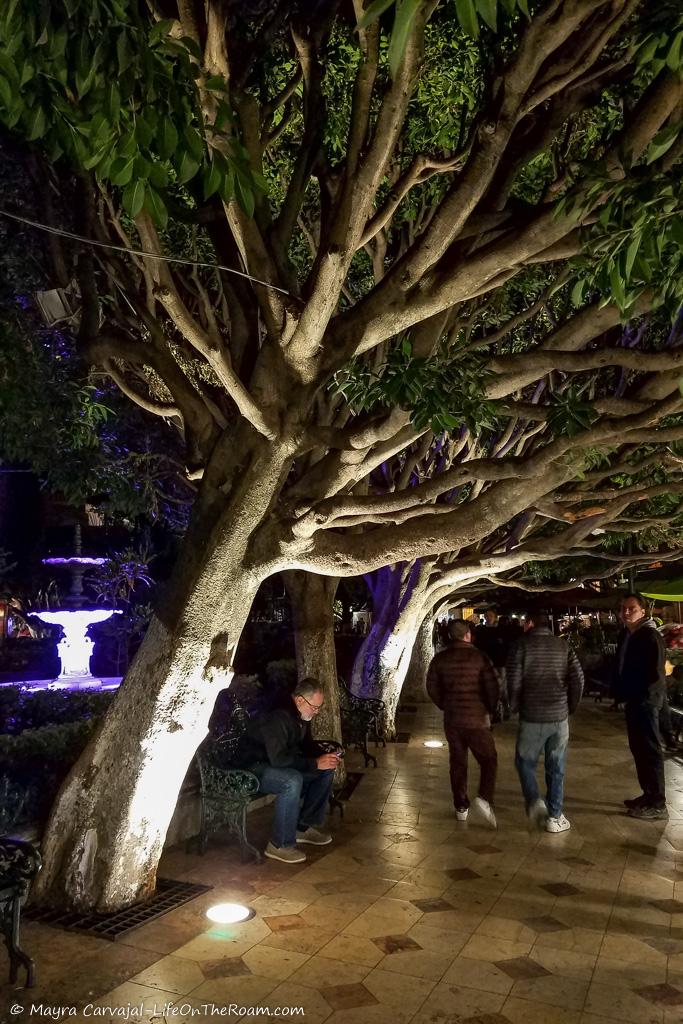
Teatro Juarez is also beautiful at night with lights accentuating the cornice, the balustrade and the soffit.
If you’re planning to spend the night in Guanajuato, book your stay in the centre. Being able to step out of your accommodation and walk everywhere will make it more convenient.
Ready for day 2?
Day 2 in Guanajuato: Explore the Outdoors and the Mummy Museum
If you’re looking for unusual things to do in Guanajuato there are plenty of hiking trails nearby with different lengths and levels of difficulty, biking trails, and ATV tours. You can spend half a day or all day enjoying the mountain views.
Hike the Sierra de Santa Rosa Nature Preserve
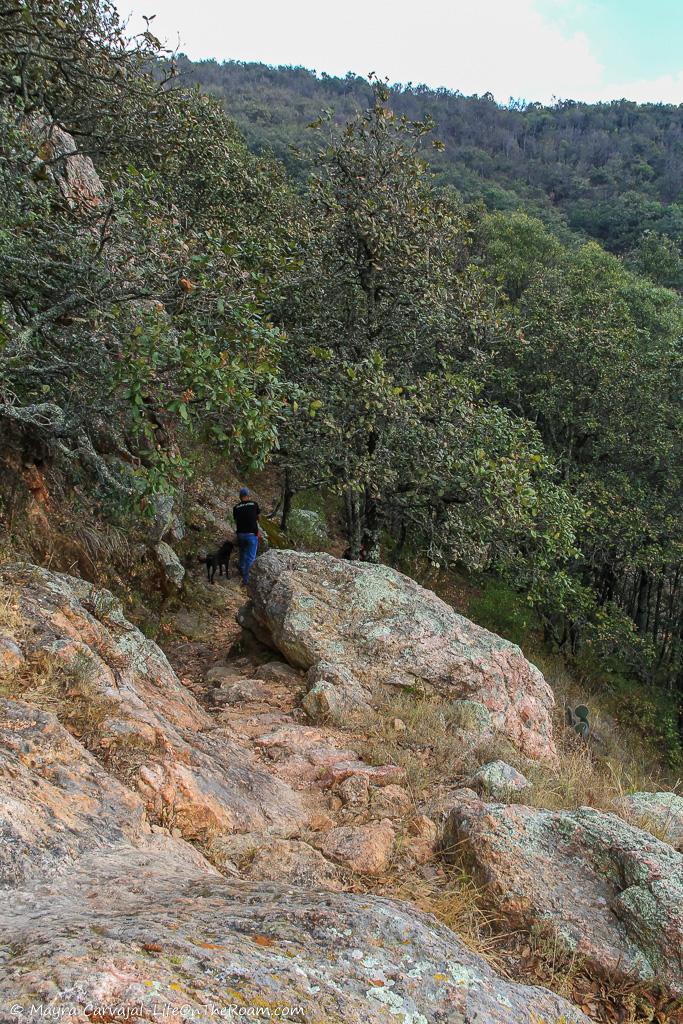
Of the different trails in this area, we did the Sierra Santa Rosa to Presa Peralillo loop, a five-mile trail with easy to moderate difficulty that goes through an oak forest leading to a dam in the mountains.
The trailhead is located around the last section of the cobblestone road leading to the hilltop of the Santa Rosa de Lima village (off the Guanajuato Dolores Highway), located approximately 30 minutes from Guanajuato’s centre by car.
Finding the exact location of the trailhead is a little bit tricky as there are no signs -we went with a friend who is a local- so you may want to book a Santa Rosa hiking tour from Guanajuato (and you won’t need to rent a car).
The trail takes you through an oak forest that leads into an open field (say hi to the cows) before re-entering the forest with amazing views.
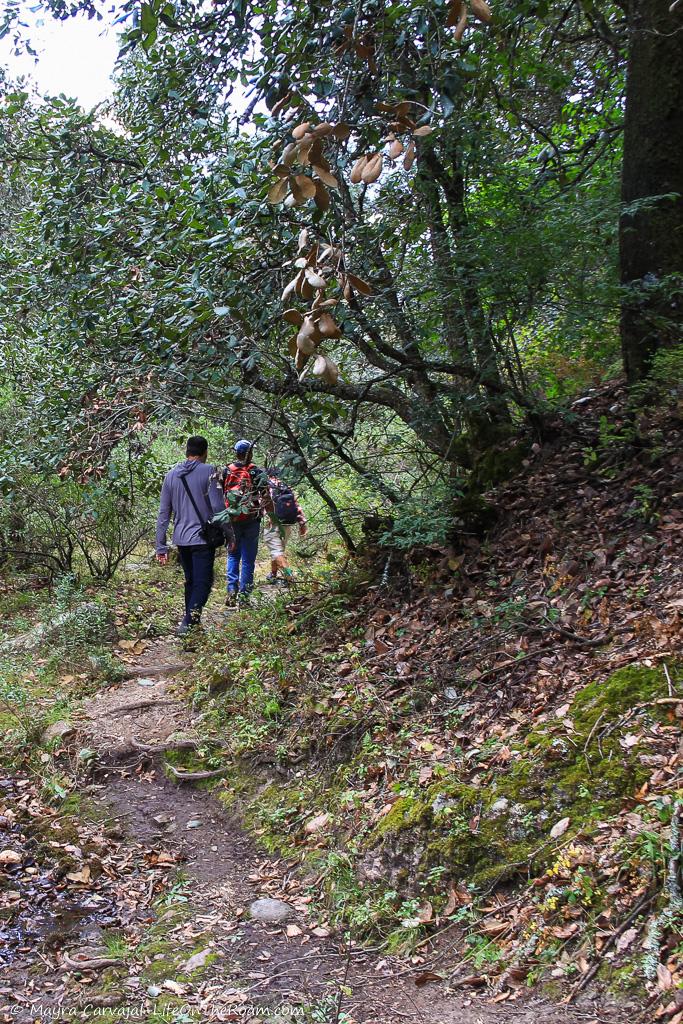
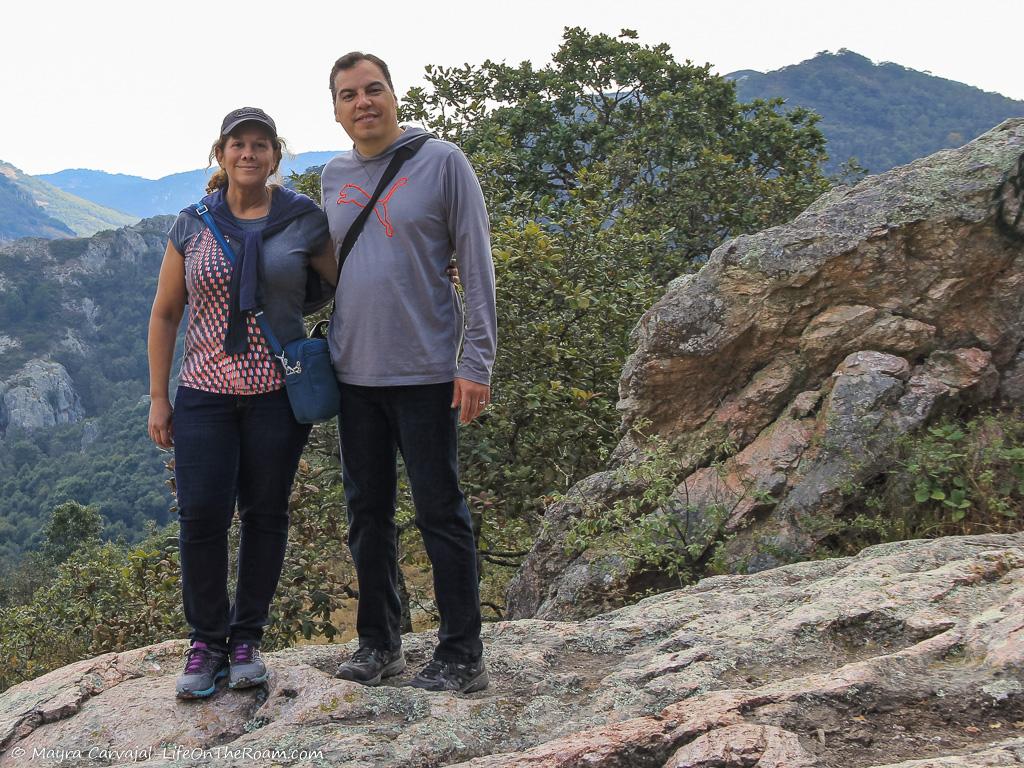
The turning point is Presa Peralillo, a dam reflecting the silhouette of the surrounding mountains.
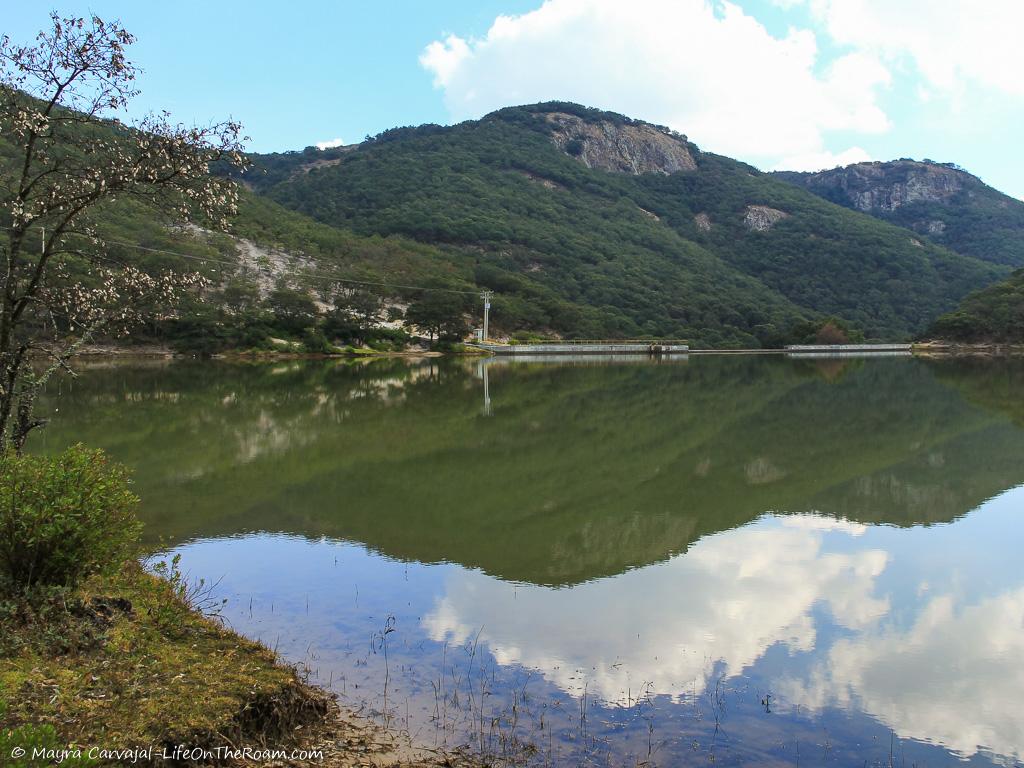
You’ll enjoy the beautiful forest one more time on your way back to the trailhead.Feeling hungry after the hike? On your way back, right before reaching the highway, stop at the Restaurant de La Sierra for a good meal, with a mountain view.
Another hike you can try is Cerro de la Bufa. It’s an intermediate level trail with great views and a beautiful landscape. You can book this guided hike, with a rating of 4.9/5 based on 20 reviews.
H
H
See the Smallest Human Mummy in the World at the Museum of the Mummies of Guanajuato
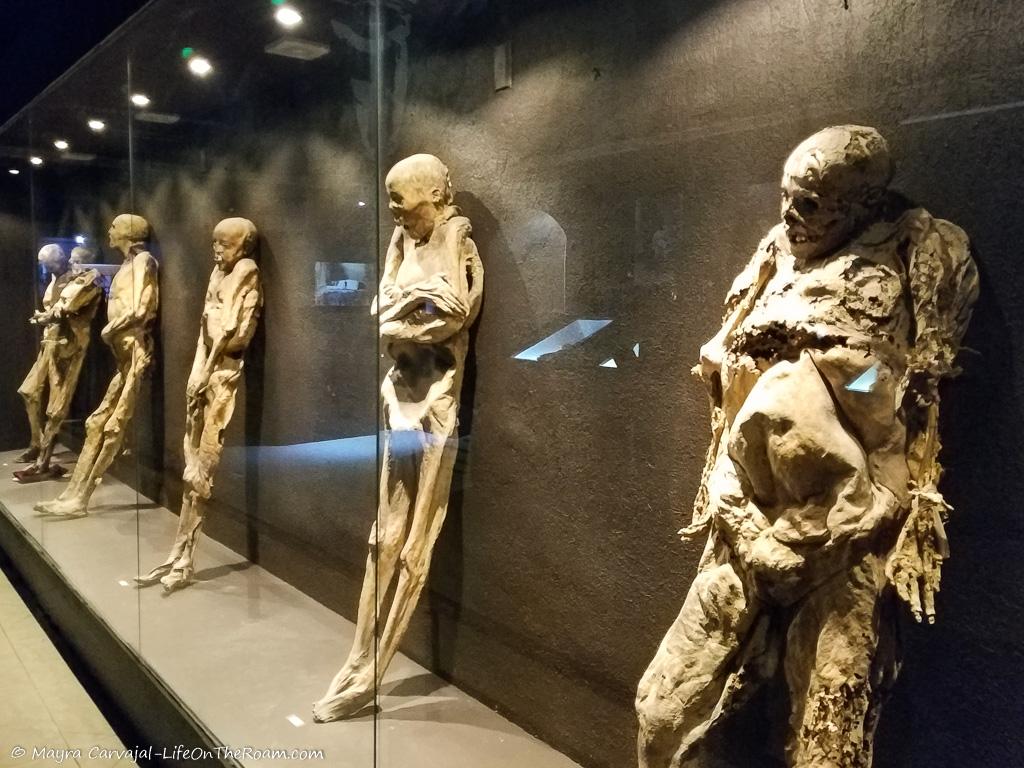
You may gasp in horror or you may find it interesting from an archaeological point of view. Recent archaeology, I must add, as these mummies are less than 200 years old.
In Mexico, the museum isn’t that creepy (unless you’re planning to bring small children – don’t !).
Keep in mind that most Mexicans are fascinated with death (in a way, aren’t we all?). Day of the Dead parades, colourful skulls everywhere, catrinas (beautifully decorated and dressed up skeleton-like figures -I love them!), you name it.
In the late 1800s that fascination led the gravediggers to charge curious locals to see the mummies they were digging out of vertical crypts in the cemetery, keeping them at a site that is now the museum.
Where do the mummies in Guanajuato come from?
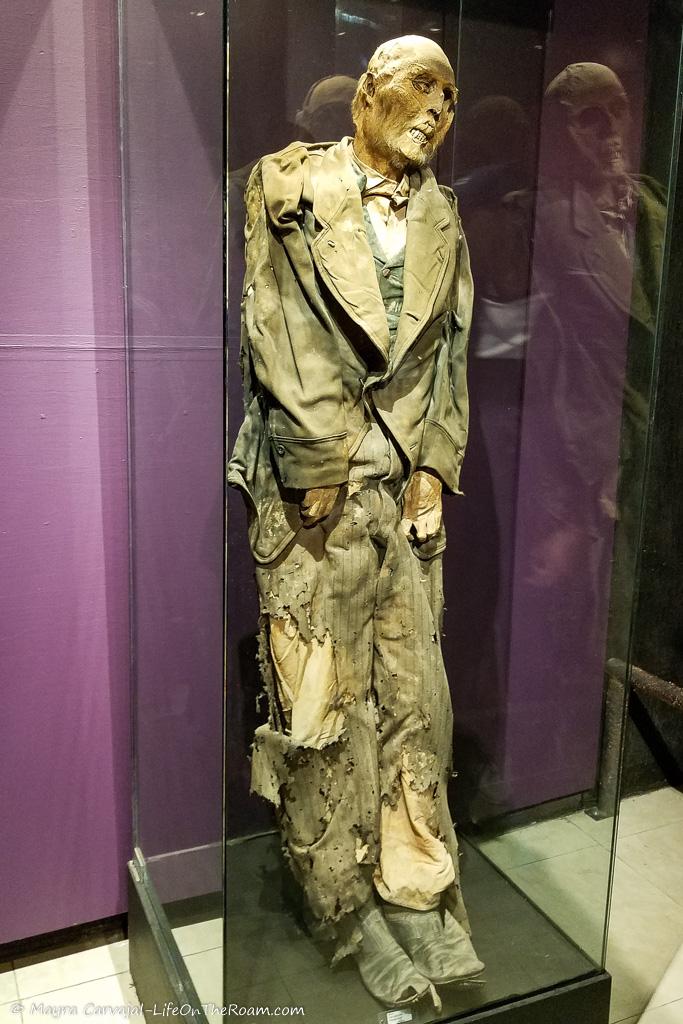
The City of Guanajuato discovered the natural mummification of the bodies when it proceeded with the exhumation of corpses whose families stopped paying the burial tax (this practice ended in 1958).
Once the payment was overdue the city dug the vertical crypts -most of them burying victims of the cholera outbreak of 1833- to make space for new burials and found the mummified bodies. Their skin was preserved only by the absence of moisture and humidity of the arid soil of Guanajuato, high up in the mountains.
The city declared the funerary remains a cultural heritage. Specifically, a “Movable Cultural Property and Common Heritage of Mankind”, as a “testimony of the evolution of nature”.
The mummies tell stories about the people they once were and the last moments of their lives. Some are horrific.
Ignacia Aguilar was mistakenly declared dead and buried alive. The position of her body and facial marks reveal the desperation of her final moments after she woke up underground.
It’s not a pretty image.
Or the man who drowned. The blue-ish colour of the skin tells the tale of his death.
The smallest human mummy in the world is here. A perfectly preserved six-month fetus, with the mouth wide open, who died inside the body of the mother.
Her fragile bones indicate that she wasn’t properly nourished to support a pregnancy at 40. Sorry, that image is a little bit too creepy so you’ll have to go and see it for yourself.
With around 100 mummies on display, this is a big collection you want to see at your own pace.
“Can’t wait to visit” or “No thanks, I’ll pass”?
From the centre (across the Basilica) you can take the bus with the “Las Momias” sign or take a taxi.; Open daily: 9AM-6PM (Friday to Sunday open till 6:30PM); General admission: MXN 85.00
How to Get to Guanajuato
By Bus
It’s easy to reach Guanajuato by bus from other popular destinations in Mexico. These are approximate travel times:
From San Miguel de Allende: 1.5 hours. This is a popular day trip.
From Santiago de Queretaro: 2.5 hours
From Guadalajara: 4 hours
From Mexico City: 4.5 hours
From Puerto Vallarta: 8.5 – 10 hours (overnight trip)
Some cities have different terminals. Make sure you double-check the location.
Tip: the Guanajuato bus terminal is 15-20 minutes by car from the centre, depending on traffic. Once you arrive you can take the local bus with the “Centro” sign on the front.
Primera Plus and ETN offer safe and comfortable rides connecting the Central de Autobuses (Bus terminals). You’ll find online schedules and fees.
www.primeraplus.com.mx; www.etn.com.mx
By Air
The Guanajuato International Airport (Bajío International Airport (BJX)) is 30 minutes away by car from the city centre, with local and international flights.
Are you feeling inclined to see if Guanajuato is indeed the most beautiful city in Mexico? I’m sure all the historic buildings, beautiful squares, and surrounding nature will make a strong case for that number one spot.
YOU MAY ALSO WANT TO READ
BOOKING FLIGHTS AND ACCOMMODATIONS
Book your flight without losing your shirt
We check Momondo to find great deals to book our flights. Also, check Great Escape: it combines the listings from Expedia, Kiwi, Kayak, (and Skyscanner on the premium service) to find the best airfares.
To find a place to stay for less
Booking.com: this site combines everything under the sun. You’ll find hotels, apartments, B&B, hostels, rooms, etc., with all sort of filters to make your search a breeze.
Hotwire: the first site I check when we plan to stay at a hotel for a few nights. You can save anything from 20% to 60%. Use the search filter to find what you want and you’ll end up with three listings that match your criteria. You’ll know which one you’ll get after you book. If you can handle a little bit of uncertainty you can score big savings.
House Sitting: you take care of people’s pets and house for free while staying for free. It’s the closest thing to experiencing a place “like a local”. But it comes with responsibilities… Are you an animal lover? It may become your new way to travel.
To get travel insurance
SafetyWing: travel medical insurance that gives us peace of mind knowing that we’re covered in case of emergency. It’s convenient, affordable, and suitable for digital nomads who spend a long time outside their home country.
Check the full list of travel resources on my Resource Page for more options and savings
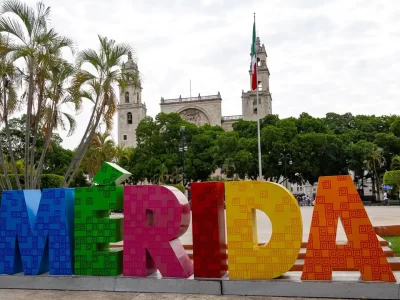

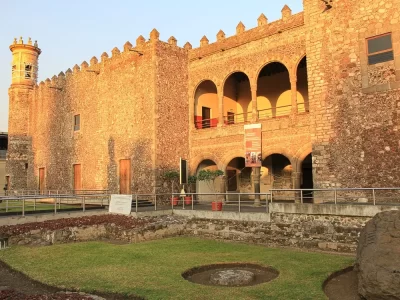
Hi Mayra,
I love your posts (not just this one). They’re so informative and thorough. I bookmarked your site for later use. Many posts are about destinations where I’m planning to visit. Many thanks for your hard word.
Thank you, Selena. I hope you can visit all these amazing places.
Wow! There’s so much that you can do in 2 days. I haven’t visited Mexico yet. The historical architecture of the museums is great.
Yes! Tons of things to do. If you like historic buildings put Mexico on your list.